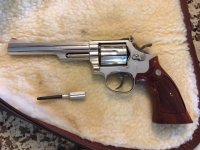As I understand it,the combination of the characteristics of the 125 gr load, and the flats on the K -frames, led to examples of top strap cutting.
No, it didn't. The "flat" is a relief cut on the bottom of the barrel, at the rear and does reduce the thickness of the barrel at that point, but it has nothing to do with topstrap flame cutting.
Additionally topstrap flame cutting is not a structural issue, it is a cosmetic issue. The blast of certain hot powders out of the cylinder gap will cut a groove in the topstrap steel, but it is a self limiting thing, and does not cut enough metal to weaken the topstrap.
Forcing cone cracking, on the other hand is a different matter and does deadline the gun. And the thin portion of the barrel where the flat is, is the most common place it cracks.
Even when the K frames (models 19 and stainless versions) went to a steady diet of magnum ammo in police use, (including practice) they served normally for quite a while (like through the 1960s) without abnormally high failure rates, shooting the standard magnum 158gr loads.
When the police switched over to the hot 125gr loads for general use (street and practice) that's when problems with forcing cones began to show up at an abnormally high rate. And while gun legend makes it seem like ALL the guns had issues, very few actually did. While I don't have the actual figures, I understand that the "abnormally high failure rate" was something like 7 guns out of 1,000 instead of 2.
AND, sometimes the failures were due to user error. One case I personally saw was a model 19, where the shooter had badly leaded the bore, didn't clean it, and went to shooting the hot magnum ammo, and the forcing cone cracked, literally because it was abused.
From what I've heard, most of the actual problems were mostly with the early stainless guns (mod 65 & 66) and were the result of insufficient testing before the production and Bangor Punta's push to get guns out the door. Can't say for certain, but that's what I've heard. Make no mistake, some guns did fail, it was a problem and it got fixed, but the tales grew in the telling, and the problem was not as widespread as todays stories make it seem.
At the same time, the duty belt of officers was growing more and more of a burden, and the big N-frames, suitable for mag loads, added to the load and resulting clumsiness. Enter the L-frame.
The weight of equipment officers had to carry did go up, quite a bit, but the L frame guns didn't solve that. Not a bit. With the same barrel length, the L frame weighs exactly the same as the N frame. They are NOT lighter. They just balance differently and have a slightly smaller (K frame size) grip frame.
The L frame was not a solution to the weight of an N frame, they weigh the same.

